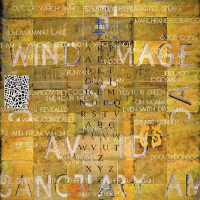53. IMANTS TILLERS

In 1997, Imants Tillers made the impulsive, not completely conscious and considered choice to move with his family from Sydney to Cooma, a small town in south-eastern New South Wales.1 This fundamental shift from the urban to regional offered rich new topography to probe the artists recurring interests in locality and identity, and reinforced his appreciation for indigenous art so essentially bound to landscape. Since we moved to this (some would say) godforsaken, bleak, arid, treeless landscape called the Monaro, Tillers has written, an awareness of landscape has become inescapable to me. Every journey, on foot or by bus, car or aeroplane, entails contact with the austere local vistas of a landscape tempered by heat, frost, drought and decomposing granite.2
Drawing on these experiences traversing Monaros vast grasslands, like artist Rosalie Gascoigne (1917-1999) who similarly lived and worked in the region, Tillers too has turned to depict the environment not in literal representation of natural features, but as evocations in text and other layered visual elements.3 Presenting a postmodern approach to nature as essentially mediated and constructed, mapping bears manifold meaning as both subject and methodology. Just as philosopher Jean Baudrillard proposed the map today precedes the territory, Tillers posits a parallel of our mediated experience of nature with that of Australian encounters with art, noting that reproductions of artworks have long preceded direct experiences whilst distance from art-world centres has relegated local output to the periphery.4 Trading on these conditions, Tillers harnesses modes of mapping as a gambit to restore representations of nature in art with the texture of experience.
In Sanctuary I, the consolidation of 54 canvas boards creates at once the familiar folded creases of a well-worn map, and in its flattened field evokes the boundless sun-bleached land itself that Gascoigne once described as all air, all light, all space, all understatement.5 In dialogue with her own assemblages, Tillers has utilised both readymade canvas board but as well the ready-made poetry of both Anglicised and Indigenous names of localities and geographical features in the vicinity.6 Across the patchwork grid of weathered dusty gold, stencilled words are swept and strewn across the labelled tableland as though carried by the wind, leaving text truncated in a palimpsest of rural road signs and prose alike.
Crucial to Tillers idiosyncratic practice is an intellectual and philosophical acuity that informs his appropriation and reference to a pantheon of artists and ideas. Gathering disparate threads to converge with unexpected resonance, Tillers invites audiences to engage with multiple and inclusive subjectivities.7 Here we encounter several of Tillers key influences; a fragment from Japanese-American artist Shusaka Arakawas book The Mechanism of Meaning 1979 (the distance out of which who repeatedly hypostatised speaks); a segment of Emily Kame Kngwarreyes (1910-1996) masterpiece Anwerlarr Anganenty (Big Yam Dreaming) 1995, and French poet Stephane Mallarm whose phrase a throw of the dice will never abolish chance borders this work and several others in Tillers Nature Speaks series.
Another citation of Mallarms - Everything in the world exists to end up in a book - provides the metaphoric backbone of the artists ongoing Book of Power.8 Since 1981, Tillers has organised the entirety of his painted canvas board panels into a sequential system numbered from one to infinity, describing his quixotic project as an all-encompassing book, inventory, compendium, neural network or maybe even, to use Arakawas term, a crude model of being.9 Each panel thus simultaneously speaks to each works gestalt but as well to Tillers overall oeuvre.
Whether culminating in modular compositions or resting deconstructed in unmounted stacks, these works arrest in their enigmatic and engaging coalescence of history, culture, and place, Tillers remaining one of Australias most compelling contemporary artists.
Footnotes:
1. 2001 Facsimile from Imants Tillers to Graham Coulter-Smith, quoted in Coulter-Smith, G., The Postmodern Art of Imants Tillers: Appropriation en Abyss, 1971-2001, Southampton Institute and Paul Holberton Publishing, Southampton and London: 2002, p.186
2. Tillers, I., When locality prevails, Heat no.8, Giramondo, Sydney, 2004, p.114
3. Ibid.
4. Tillers, I., In Perpetual Mourning, Art + Text/ZG, (joint issue), New York, July 1984, p. 15, quoted in Curnow, W., Imants Tillers and The Book of Power, Craftsman House, Sydney, 1997, p.74
5. Rosalie Gascoigne interview with Peter Ross, ABC, 1990, quoted in Edwards, D., Rosalie Gascoigne, MCA Collection Handbook, https://www.mca.com.au/artists-works/artists/rosalie-gascoigne/
6. Tillers, I., When Locality Prevails, p.114
7. Newman, M., The artist as translator, quoted in Imants Tillers: Works 19781988, exhibition catalogue, The Institute of Contemporary Arts, London, 1988, n.p., quoted in Hart, D, Bringing the periphery centre stage, Imants Tillers: One World Many Visions, National Gallery of Australia, Canberra, 2006, p.36
8. Coulter-Smith, G., The Postmodern Art of Imants Tillers: Appropriation en Abyss, 1971-2001, p.199
9. Tillers, I., Metafiscia Australe, Art + Australia, Issue One (53.2), 2017, https://www.artandaustralia.com/online/metafisica-australe
Carla Dusevic BA (Hons)